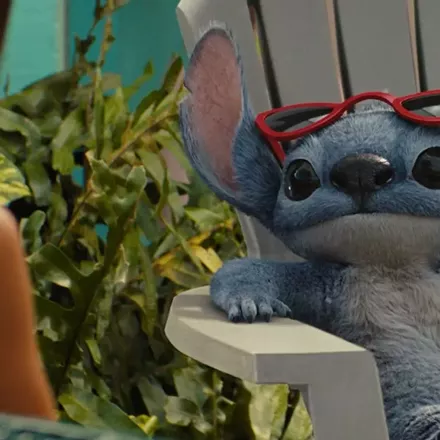The Secret of Kells
Illumination Building: The Secret of Kells gives Irish history beautifully distinct animation.
By Scott Renshaw @scottrenshawLike many Animated Feature nominees in recent years, The Secret of Kells is a marvel of technical artistry—and also like many Animated Feature nominees, it doesn’t work as well if you care about the story.
Director Tomm Moore’s Irish tale was inspired by the real-life Book of Kells, an illuminated Bible considered one of the nation’s great artistic treasures. The film addresses the creation of the work during the first millennium A.D., at a time when Viking hordes were routinely invading Ireland. At the abbey of Kells, an orphaned boy named Brendan (Evan McGuire) is living under the care of his uncle, the abbot (Brendan Gleeson). All attention is focused on building a massive wall to keep out the feared “Northmen,” but Brendan becomes more interested in the arrival of Brother Aidan (Mick Lally), a refugee from the invaded island of Iona who brings with him the work-in-progress book.
Moore and screenwriter Fabrice Ziolkowski use that framework as a means of touching on a number of themes, most notably the transition from a pagan to Christian Ireland. Brendan befriends a forest faerie named Aisling (Christen Mooney), and ventures into the cave of the demon/deity Crom Cruach on a quest for a powerful crystal. It’s rich material, but despite the conflict between the abbot’s defensive posture and Brother Aidan’s more evangelical bent, The Secret of Kells keeps the religious content fairly simple and inoffensive.
And “simple” really defines the entire narrative arc, which barely bothers with making Brendan a character at all. The opening sequence offers the promise of a feisty, playful lad trapped behind the abbot’s walls, but ultimately it’s hard to distinguish him from a hundred other generically adventurous, acceptably rebellious kid-flick protagonists. There’s more than a little bit of history lesson to The Secret of Kells—and unfortunately, from a narrative standpoint, it feels like it.
History would still be a lot more fascinating, however, if textbooks could provide the kind of visual pop we get here. The basic human character designs are interesting enough, the people often rendered as composites of geometric figures. But Moore and his animators get terrifically creative with other characters, including the pale Aisling with her stream of flowing hair. The invading Vikings become shadowy blocks with rudimentary horns and glowing eyes, abstract figures of chaos; the wolves Brendan encounters in the forest are similarly primitive and monstrous. It’s eye-popping, thrillingly artistic stuff.
And the style given to individual scenes—often colored and crafted to evoke medieval illuminations—is just as charged with invention. At times, Brendan’s chalk-and-slate drawings come to light to portray his imaginative visions; occasionally, the screen will break into panels to convey the equivalent of a montage or the passage of time. Both from a presentation and a content standpoint, this is most definitely not stuff for little kids, whether it’s depicting the violent horror of the Viking siege on Kells or Brendan’s stylized battle with a serpent.
It does seem a shame that, with so much care and imagination invested in the way The Secret of Kells looks, there couldn’t have been a bit more creativity injected into the story. On a rudimentary level, the narrative could have been something dropped into a Catholic Church-approved bit of faith-promotion, with only the portrayal of the childlike Aisling remaining non-committal about non-Christendom. If you turned the sound down, you really wouldn’t miss a thing about The Secret of Kells that’s worth paying attention to. Maybe that’s the way Oscar voters watched it. And maybe they were still right in finding something worth honoring.
THE SECRET OF KELLS
Brendan Gleeson, Mick Lalley, Evan McGuire
Not Rated
|
Scott
Renshaw:
|
Speaking of...
-
Robin Hood
We Wuz Robbed: Ridley Scott’s Robin Hood can’t deliver promise of a story behind the legend.
- May 12, 2010
-
Iron Man 2
Stark Contrast: Iron Man 2 leaves you wanting more of the guy who made the original fly.
- May 6, 2010
-
Babies
Natal Habitat: Babies observes cultural differences—and overly precious cuteness.
- May 5, 2010
- More »
More by Scott Renshaw
-
Film Reviews: New Releases for May 30
Karate Kid Legends, Bring Her Back, Jane Austen Wrecked My Life, Bad Shabbos, Tornado
- May 29, 2025
-
JANE AUSTEN WRECKED MY LIFE, BRING HER BACK, June 2025 Special Screenings
Two new releases, plus SLFS Summer Showdown, Wild & Scenic Festival and more.
- May 28, 2025
-
Film Reviews: New Releases for May 23
Lilo & Stitch, Mission: Impossible - The Final Reckoning, Friendship, Fountain of Youth, The Last Rodeo
- May 22, 2025
- More »
Latest in Film Reviews
Readers also liked…
-
Sundance 2025 wrap-up plus February special screenings
Uncertainty about the future location shifts focus away from the movies
- Feb 5, 2025












